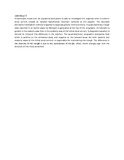An Investigation of the Equatorial Orographic–Dynamic Mechanism

View/
Date
1985Author
Semazzi, Fredrick H. M.
Type
ArticleLanguage
enMetadata
Show full item recordAbstract
A barotropic model over an equatorial beta-plane is used to investigate the response when a uniform zonal current crosses an isolated hypothetical mountain centered at the equator. The bounded derivative initialization method is applied to suppress gravity–inertia motions. A quasi-stationary trough (also reported in an earlier paper by Semazzi) is generated at the top of the orography. Its intensity is greater in the easterly case than in the westerly case of the initial zonal current. A diagnostic equation is derived to interpret this difference in the solution. The quasi-stationary orographic divergence field which is positive on the windward slope and negative on the leeward slope (for both easterly and westerly cases of the initial zonal current) is responsible for maintaining the trough. The difference in the intensity of the trough is due to the contribution of the βu- effect, which changes sign with the direction of the initial zonal flow
URI
http://journals.ametsoc.org/doi/abs/10.1175/1520-0469%281985%29042%3C0078%3AAIOTEO%3E2.0.CO%3B2http://hdl.handle.net/11295/66439
Citation
Semazzi, Fredrick H. M., 1985: An Investigation of the Equatorial Orographic–Dynamic Mechanism. J. Atmos. Sci., 42, 78–83.Publisher
University of Nairobi
